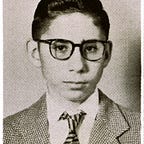El Trapo Negro de Manuel Álvarez Bravo
For me this Medium essay is a test.
I began my career in photography in Vancouver BC in 1975. Before that I was a high school teacher in Mexico City. With my Canadian wife and two Mexican-born daughters we drove north in our VW Beetle.
Until a couple of years ago, when the bottom fell on paid magazine work in Vancouver and in most of Canada I retired. But from the year 2000 for about 12 years I exhibited in local galleries. Most of my work consisted of what I love to do and that is to shoot female nudes.
Now in this century, in a time when social media and the internet show everything, those nudes that I took and only exhibited in galleries are in my extensive files and might see the light of day when I am dead. I showed many of them (cropped so as not to show bits and pieces) in my daily blog (since January 2006). But I would not dare put any of my nudes, one because I respect my subjects and two because many, particularly in this strangely conservative city would be offended.
But it has occurred to me that I might place a few here in Medium and not link them to Facebook or Twitter. Only those who know the existence of Medium might find them.
Now to the story of the pictures here which I am placing thinking of my new Medium friend Raphael Shevelev who wrote this intelligent essay recently.
I pleasantly disagreed with him and that’s how the friendship began.
I lived in Mexico (Veracruz, Nueva Rosita, Coahuila and Mexico City) for 18 years. I am a native of Buenos Aires so Spanish is my first language. While in Mexico, particularly in the 50s I lived the golden era of Mexican film and art. Many of the famous muralists were still alive. Without knowing then I was living two blocks from the house where Edward Weston lived and photographed Tina Modotti on the roof.
It was later on that I found out that before leaving Mexico Weston gave one of his 4x5 inch cameras to Modotti. When Modotti was expelled from Mexico (for being a communist) she gave her camera to a younger Manuel Álvarez Bravo. I like that continuation.
Manuel Álvarez Bravo in an interview with the NY Times when he was in his 90s informed his startled interviewer that he began his day with coffee and the going to his studio to photograph a woman in the nude. Bravo died when he was 100 in 2002.
He took a photograph in 1986 when he was 84. It is an amazing photograph that I see as a portrait. Why?
When I look at the photograph (with the strange name of the black cloth in which trapo really refers to something you use to clean a floor but does look like a Mexican rebozo or shawl) I see a proud woman with an erect bearing and a beautifully elegant hand. I can feel the heat and smell the dirt of the land. I do not need to see her face to know she is part Native Mexican.
For years I have admired this photograph. As I became older, the hope that I might be able to take as an iconic photograph as that one was thrilling. Unlike Douglas MacArthur and other generals I did not need to fade away in my old age.
I had my chance to photograph my version of Bravo’s photograph 8 years ago. While teaching photography at a local school I noticed that one of my students was a female Mexican from León Guanajuato. After a few months and when her class was over I felt I could ethically ask her to pose for me this she did.
It was in the middle of a long week of wintery cold and rainy weather when I took the shot in my studio. I faked the clouds by using a gobo with a focusing spotlight.
I did not use a black rebozo. I used my mother’s red Mexican rebozo of which I have taken a series that you can see here.
That is why I am also including here the colour version.
From that Trapo Negro version by yours truly the girl from Leon and I explored our nostalgia for a country with heat, and red dirt — a country with green mountains in the summer which turn to ochre-red in the winter. When I look at her photographs I can smell the tortillas at a tortilla factory, the scent of a Manila mango and a ripe pineapple.
I am 74.
